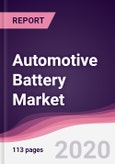What is Automotive Battery?
Battery is device made of electrochemical cells that convert stored chemical energy to electrical energy and electrical energy to chemical energy. Automotive battery is a rechargeable electronic device that supplies electrical energy to automobiles. Traditionally, batteries are used for starting engines, powering cranking motors, interior circuits, external appliances and telematics in automobiles. These batteries are majorly employed in passenger vehicles, electric vehicles, commercial vehicles and among others
What are the major applications of Automotive Battery?
The major application of automotive battery includes automobiles such as cars, two wheelers, and commercial vehicles. There are various types’ automotive batteries like lead acid, lithium Ion, nickel cadmium, and others. Basically lead based batteries are used in conventional internal combustion vehicles, start-stop and basic micro hybrid vehicles for the purpose of start, lighting and ignition. Lithium Ion batteries are used in plug in hybrid vehicles and Battery Electric Vehicles (BEV).
Researchers from universities have designed a thin plastic membrane which allows battery to be rapidly charge and in addition stops the discharging when battery is not is operation. According the researchers, this smart membrane technology will enable powerful batteries called as redox transistor batteries. The smart membrane was designed by combining polycarbonate filter with conductive polymer. In the long-term, other novel battery technologies such as zinc-air, lithium-sulphur, and lithium-air are anticipated to become competitive for use in electric vehicles, and can theoretically deliver higher energy densities than lithium-ion chemistries.
Performance of a battery in different temperature poses a significant challenge in wide adoption. It is difficult to engineer a battery which provides similar performance in both high and low temperature regions. Initially nickel-metal hydride batteries have been an important technical resource in the rise of hybrid and electric vehicles, their potential for further market penetration has been reduced currently given the increased performance and reduced cost of lithium-ion batteries.
Increasing Manufacturing Capacity: The increasing demand for Lithium Ion can be witnessed from across the OEM due to high energy density and increased power per mass battery unit, allowing the development of batteries with reduced weight and dimensions at competitive prices. Moreover with the increasing demand and economies of scale playing a huge role and players such as Tesla building manufacturing units which can produce 105 GWh of lithium.
The major players in the electric vehicle market like Panasonic, LG Chem, Samsung SDI, Lishen, CATL, Tesla, etc. are planning to increase the current production capacity and increasing investments for research and development.
Enhanced Flooded batteries are the new trend in automotive batteries. They are suitable for standard start-stop vehicles and feature a unique polyester scrim that holds the active material inside the plate. This reduces the loss of active material and results in higher cyclic stability than conventional starter batteries.
Who are the Major Players in Automotive Battery Market ?
The companies referred in the market research report include Exide technologies, Robert Bosch GmbH, Johnsons controls and more than 10 other companies.
What is our report scope?
The report incorporates in-depth assessment of the competitive landscape, product market sizing, product benchmarking, market trends, product developments, financial analysis, strategic analysis and so on to gauge the impact forces and potential opportunities of the market. Apart from this the report also includes a study of major developments in the market such as product launches, agreements, acquisitions, collaborations, mergers and so on to comprehend the prevailing market dynamics at present and its impact during the forecast period 2020-2025.
Key Takeaways from this Report
- Evaluate market potential through analyzing growth rates (CAGR %), Volume (Units) and Value ($M) data given at country level – for product types, end use applications and by different industry verticals.
- Understand the different dynamics influencing the market – key driving factors, challenges and hidden opportunities.
- Get in-depth insights on your competitor performance – market shares, strategies, financial benchmarking, product benchmarking, SWOT and more.
- Analyze the sales and distribution channels across key geographies to improve top-line revenues.
- Understand the industry supply chain with a deep-dive on the value augmentation at each step, in order to optimize value and bring efficiencies in your processes.
- Get a quick outlook on the market entropy – M&A’s, deals, partnerships, product launches of all key players for the past 4 years.
- Evaluate the supply-demand gaps, import-export statistics and regulatory landscape for more than top 20 countries globally for the market.
Table of Contents
Methodology

LOADING...








